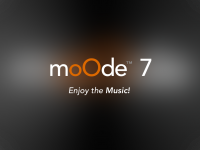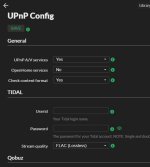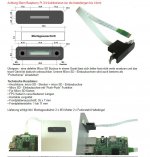Hmmh.
Tim mot interested !?!? Can't believe that. 😀
Anyhow.
You simply need to edit a certain file as described over here:
Datasheet DAC2 HD | HiFiBerry
I'd say basically all you'd have to do is to add
to the /boot/config.txt file.
That enables the Hifiberry DAC Plus HD driver and loads it after the next reboot.
Of course the driver would have to be enabled inside the Moode kernel.
Since Tim uses standard and pretty up2date kernels I'd say it should be enabled by default
and the overlay should be accessible.
HifiBerry is known to provide quality drivers. I wouldn't expect any huge challenges from that side.
The procedure is pretty much the same on all RPI OSes out there btw.
Good luck.
Tim mot interested !?!? Can't believe that. 😀
Anyhow.
You simply need to edit a certain file as described over here:
Datasheet DAC2 HD | HiFiBerry
I'd say basically all you'd have to do is to add
Code:
dtoverlay=hifiberry-dacplushdto the /boot/config.txt file.
That enables the Hifiberry DAC Plus HD driver and loads it after the next reboot.
Of course the driver would have to be enabled inside the Moode kernel.
Since Tim uses standard and pretty up2date kernels I'd say it should be enabled by default
and the overlay should be accessible.
HifiBerry is known to provide quality drivers. I wouldn't expect any huge challenges from that side.
The procedure is pretty much the same on all RPI OSes out there btw.
Good luck.
Last edited:
I forgot.
Once enabled you can use the "alsamixer" tool to set the audio device config.
I'm not sure if Mode would be overriding these settings though.
Since Moode is obviously now using a database in the background to handle these kind of
configs things like that get more tricky.
####
Just read a bit about the history of the subject. Interesting.
I fully understand the HifiBerry position. They even have their own OS.
If they say, drop us a mail and you'll get a device for integration purposes, I think
it's OK. Tim has an interest to have all devices supported, they have an interest
to sell their devices. It's always been like that.
Enjoy.
Once enabled you can use the "alsamixer" tool to set the audio device config.
I'm not sure if Mode would be overriding these settings though.
Since Moode is obviously now using a database in the background to handle these kind of
configs things like that get more tricky.
####
Just read a bit about the history of the subject. Interesting.
I fully understand the HifiBerry position. They even have their own OS.
If they say, drop us a mail and you'll get a device for integration purposes, I think
it's OK. Tim has an interest to have all devices supported, they have an interest
to sell their devices. It's always been like that.
Enjoy.
This is not true if I read the relevant threads and posts, and I fully support Tim's point of view. Moode is a free download but hardware is hardly ever free. The one exception (in my case) was when Nelson Pass handed out free H2 kits a year ago and sent me one too. This topic is not worth debating any longer and I will certainly not support HiFiBerry.Hmmh.
Tim mot interested !?!? Can't believe that. 😀
Hi,
moOde 7.0.1 is available. 🙂 This is a bugfix release. Visit the Forum for more information.
moOde 7.0.1 is available
-Tim
moOde 7.0.1 is available. 🙂 This is a bugfix release. Visit the Forum for more information.
moOde 7.0.1 is available
-Tim
Attachments
I don't understand at all what you base your response on regarding my question, but thank you for the warm welcome in this topic.
If with your pretty costly setup Moode still sounds better to you then Volumio,
assuming the same bits are send from A to B, you better get in touch
with Ian and ask for refund.
Why?
All what these super (HW) tweaks ( you can put these USB bridges on the list of super tweaks) are supposed to do is cleaning up the environment and shape the stream.
Usually no bit values get changed while doing it!
All I am saying. In a perfect world software configuration changes shouldn't have
any impact on the (perceived) soundquality.
Since most of us do have all but a perfect setup, different SW configurations did make and still make a slight difference. ( I couldn't listen to my KTB DAC without all my OS tweaks in place 😛 )
Your setup supposedly plays in a different league than most other setups out there though.
Advise:
Next time you start such a costly project ask for in-depth measurements first. 😉
It won't help much though. Your DIY solution will for sure measure differently.
And you'll never know how close to other best in class / reference setups you'd be. Anyhow. With reference measurements at hand you'd at least know about a ballpark.
With all that in mind, I'd simply go for a DAC that shows excellent performance ( have a look at the ASR reviews). My experience. The better the DAC the less impact you'll see from the OS. "better" doesn't mean more expensive nowadays. Better means isolating better from the upstream and environmental mess.
E.g. Have a look at the recent SMSL SU-9 review over at ASR. I doubt that you can achieve these kind of (industrial) performances with a DIY approach.
Anyhow.
You can tweak the Moode OS or better the underlying RPI-OS a little more of course. Still I'd suggest to talk to Ian first!
Good luck.
Enjoy.
but there are quite
a few setting / tweaking options within the MoOde setup that don't mean anything
to me
Shall we go over every setting with you?
What settings do you mean?
Concrete question <--> Concrete answer
This is not true if I read the relevant threads and posts, and I fully support Tim's point of view. Moode is a free download but hardware is hardly ever free. This topic is not worth debating any longer and I will certainly not support HiFiBerry.
Well said.
The issue is.
At one point you need to support all the new HW. If you'd refuse you'd be out of business - rather sooner than later.
The same is valid for SW evolution and development. As soon as you stop evolving another one steps in and takes over.
You're not in the drivers seat. You are being driven. And it never stops.
As long as Volumio, MaxtoPlay (who is also selling HW), pCP and the rest of the bunch support new HW, there's no other choice for you than also doing it.
It's called competition. It's not about fairness. It's about survival.
That's why you'd better appreciate getting a free integration sample. 😉
Enjoy.
At one point you need to support all the new HW. If you'd refuse you'd be out of business - rather sooner than later.
The same is valid for SW evolution and development. As soon as you stop evolving another one steps in and takes over.
You're not in the drivers seat. You are being driven. And it never stops.
As long as Volumio, MaxtoPlay (who is also selling HW), pCP and the rest of the bunch support new HW, there's no other choice for you than also doing it.
It's called competition. It's not about fairness. It's about survival.
That's why you'd better appreciate getting a free integration sample. 😉
Enjoy.
I have a question about the version jump from version 6 to 7.
This time I couldn't update via the webfront. I had to remove the SD card from the Raspberry [which is very cumbersome].
Is there a possibility that the SD card gets stuck and I copy the new image [* .iso] onto it in another way?
This time I couldn't update via the webfront. I had to remove the SD card from the Raspberry [which is very cumbersome].
Is there a possibility that the SD card gets stuck and I copy the new image [* .iso] onto it in another way?
I have a question about the version jump from version 6 to 7.
This time I couldn't update via the webfront. I had to remove the SD card from the Raspberry [which is very cumbersome].
Is there a possibility that the SD card gets stuck and I copy the new image [* .iso] onto it in another way?
I fitted an adapter to my Pi so that I could easily access the card.
Cheap and effective
Micro SD Card Extender - 68cm long flex cable– The Pi Hut
Attachments
Thanks.I've tried it once and discarded it without success or didn't try to get it to work:
You have the Tidal app on a computer and then stream it to the moodeaudio player. That bothered me
Did I miss something or is there an easy way to Tidal access.
Use Moode's UPnP Renderer, and a 3rd party app such as mconnect HD, or BubbleUPnP.
The Tidal credentials are entered into the app, and it then directs the stream to the Renderer, however the stream does not (contrary to some popular flawed opinion) actually flow through the phone or tablet, it merely acts as a control point.
I've tried it once and discarded it without success or didn't try to get it to work:
You have the Tidal app on a computer and then stream it to the moodeaudio player. That bothered me
You'll find much more information over at the MoOde forum.
Moode Forum
This thread isn't regularly monitored, the new forum is better structured so that you can see the topic relevant to your query.
Did I miss something or is there an easy way to Tidal access.
This has been discussed on the Moode forum. Ways to do it include using Bubble UPnP on Android, or Bubble Server and Linn Kazoo on PC or Mac.
Edit: I posted this before seeing the above replies.
Last edited:
- Home
- Source & Line
- PC Based
- Moode Audio Player for Raspberry Pi


